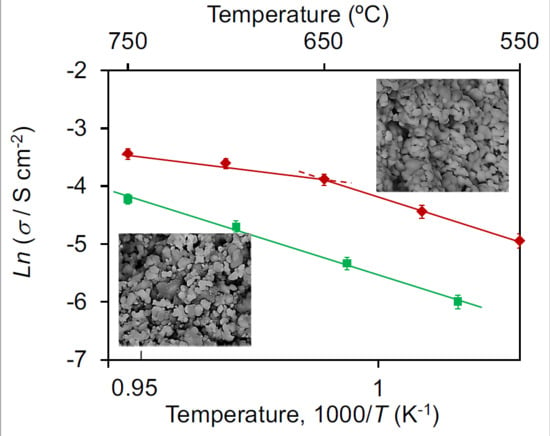Improved Electrochemical Properties of an Ni-Based YSZ Cermet Anode for the Direct Supply of Methane by Co Alloying with an Impregnation Method
Abstract
1. Introduction
2. Materials and Methods
3. Results and Discussion
3.1. Phase Identification
3.2. Microstructure of the Anode
3.3. Cell Performance for a H2 Supply
3.4. Cell Performance for a CH4 Supply
3.5. Temperature Dependence of the Anode Interface Conductivity
3.6. Prolonged Stability in CH4
4. Conclusions
Supplementary Materials
Author Contributions
Funding
Acknowledgments
Conflicts of Interest
References
- Atkinson, A.; Barnett, S.A.; Gorte, R.J.; Irvine, J.T.S.; McEvoy, A.J.; Mogensen, M.; Singhal, S.C.; Vohs, J. Advanced anodes for high-temperature fuel cells. Nat. Mater. 2004, 3, 17–24. [Google Scholar] [CrossRef]
- Zhan, Z.; Barnett, S.A. An octane-fueled solid oxide fuel cell. Science 2005, 308, 844–847. [Google Scholar] [CrossRef] [PubMed]
- Park, S.; Vohs, J.M.; Gorte, R.J. Direct oxidation of hydrocarbons in a solid-oxide fuel cell. Nature 2000, 404, 265–267. [Google Scholar] [CrossRef]
- Liu, J.; Barnett, S.A. Operation of anode-supported solid oxide fuel cells on methane and natural gas. Solid State Ion. 2003, 158, 11–16. [Google Scholar] [CrossRef]
- Armstrong, E.N.; Park, J.; Minh, N.Q. High-performance direct solid oxide fuel cells. Electrochem. Solid-State Lett. 2012, 15, B75–B77. [Google Scholar] [CrossRef]
- Muccillo, R.; Muccillo, E.N.S.; Fonseca, F.C.; de Florio, D.Z. Characteristics and performance of electrolyte-supported solid oxide fuel cells under ethanol and hydrogen. J. Electrochem. Soc. 2008, 155, B232–B235. [Google Scholar] [CrossRef]
- Kaparaju, P.; Buendia, I.; Ellegaard, L.; Angelidakia, I. Effects of mixing on methane production during thermophilic anaerobic digestion of manure: Lab-scale and pilot-scale studies. Bioresour. Technol. 2008, 99, 4919–4928. [Google Scholar] [CrossRef] [PubMed]
- Ting, C.H.; Lee, D.J. Production of hydrogen and methane from wastewater sludge using anaerobic fermentation. Int. J. Hydrog. Energy 2007, 32, 677–682. [Google Scholar] [CrossRef]
- Fountoulakis, M.S.; Manios, T. Enhanced methane and hydrogen production from municipal solid waste and agro-industrial by-products co-digested with crude glycerol. Bioresour. Technol. 2009, 100, 3043–3047. [Google Scholar] [CrossRef]
- Sanphoti, N.; Towprayoon, S.; Chaiprasert, P.; Nopharatana, A. The effects of leachate recirculation with supplemental water addition on methane production and waste decomposition in a simulated tropical landfill. J. Environ. Manag. 2006, 81, 27–35. [Google Scholar] [CrossRef]
- Gorte, R.J.; Vohs, J.M. Novel SOFC anodes for the direct electrochemical oxidation of hydrocarbons. J. Catal. 2003, 216, 477–486. [Google Scholar] [CrossRef]
- Sasaki, K.; Teraoka, Y. Equilibria in fuel cell gases I. Equilibrium compositions and reforming conditions. J. Electrochem. Soc. 2003, 150, A878–A884. [Google Scholar] [CrossRef]
- Mogensen, D.; Grunwaldt, J.D.; Hendriksen, P.V.; Dam-Johansen, K.; Nielsen, J.U. Internal steam reforming in solid oxide fuel cells: Status and opportunities of kinetic studies and their impact on modeling. J. Power Sources 2010, 196, 25–38. [Google Scholar] [CrossRef]
- Kim, H.; Lu, C.; Worrell, W.L.; Vohs, J.M.; Gorte, R.J. Cu-Ni cermet anodes for direct oxidation of methane in solid-oxide fuel cells. J. Electrochem. Soc. 2002, 149, A247–A250. [Google Scholar] [CrossRef]
- Sin, A.; Kopnin, E.; Dubitsky, Y.; Zaopo, A.; Arico, A.S.; Rosa, D.L.; Gullo, L.R.; Antonucci, V. Performance and life-time behavior of NiCu-CGO anodes for the direct electro-oxidation of methane in IT-SOFCs. J. Power Sources 2007, 164, 300–305. [Google Scholar] [CrossRef]
- Ringuedé, A.; Labrincha, J.A.; Frade, J.R. A combustion synthesis method to obtain alternative cermet materials for SOFC anodes. Solid State Ion. 2001, 141–142, 549–557. [Google Scholar] [CrossRef]
- McIntosh, S.; Vohs, J.M.; Gorte, R.J. Hydrocarbon deposits in the enhanced performance of direct-oxidation SOFCs. J. Electrochem. Soc. 2003, 150, A470–A476. [Google Scholar] [CrossRef]
- Jung, S.; Lu, C.; He, H.P.; Ahn, K.; Gorte, R.J.; Vohs, J.M. Influence of composition and Cu impregnation method on the performance of Cu/CeO2/YSZ SOFC anodes. J. Power Sources 2006, 154, 42–50. [Google Scholar] [CrossRef]
- Singh, A.; Hill, J.M. Carbon tolerance, electrochemical performance and stability of solid oxide fuel cells with Ni/yttria stabilized zirconia anodes impregnated with Sn and operated with methane. J. Power Sources 2012, 214, 185–194. [Google Scholar] [CrossRef]
- Minh, N.Q. Ceramic fuel cells. J. Am. Ceram. Soc. 1993, 76, 563–588. [Google Scholar] [CrossRef]
- Ringuedé, A.; Bronine, D.; Frade, J.R. Ni1-xCox/YSZ cermet anodes for solid oxide fuel cells. Electrochem. Acta 2002, 48, 437–442. [Google Scholar] [CrossRef]
- Grgicak, C.M.; Pakulska, M.M.; O’Brien, J.S.; Giorgi, J.B. Synergistic effects of Ni1-xCox-YSZ and Ni1-xCux-YSZ alloyed cermet SOFC anodes for oxidation of hydrogen and methane fuels containing H2S. J. Power Sources 2008, 183, 26–33. [Google Scholar] [CrossRef]
- Cho, C.K.; Choi, B.H.; Lee, K.T. Effect of Co alloying on the electrochemical performance of Ni-Ce0.8Gd0.2O1.9 anodes for hydrocarbon-fueled solid oxide fuel cells. J. Alloys Compd. 2012, 541, 433–439. [Google Scholar] [CrossRef]
- Bošković, S.; Stevanović, M. Sintering of cobalt-doped nickel oxide. J. Mater. Sci. 1975, 10, 25–31. [Google Scholar] [CrossRef]
- Silva, G.C.; Muccillo, E.N.S. Electrical conductivity of yttria-stabilized zirconia with cobalt addition. Solid State Ion. 2009, 180, 835–838. [Google Scholar] [CrossRef]
- Venkataramanan, N.S.; Suvitha, A.; Mizuseki, H.; Kawazoe, Y. A theoretical study of the effects of transition metal dopants on the adsorption and dissociation of hydrogen on nickel clusters. Int. J. Quant. Chem. 2013, 113, 1940–1948. [Google Scholar] [CrossRef]
- Li, K.; Jiao, M.; Wang, Y.; Wu, Z. CH4 dissociation on NiM(111) (M = Co, Rh, Ir) surface: A first-principles study. Surf. Sci. 2013, 617, 149–155. [Google Scholar] [CrossRef]
- Liu, H.; Wang, B.; Fan, M.; Henson, N.; Zhang, Y.; Towler, B.F.; Harris, H.G. Study on carbon deposition associated with catalytic CH4 reforming by using density functional theory. Fuel 2013, 113, 712–718. [Google Scholar] [CrossRef]
- Weerapakkaroon, W.; Ogasa, K.; Sato, K. Electrochemical activity of Ni1-XCoX-Based cermet anode for methane oxidation. ECS Trans. 2007, 7, 1695–1699. [Google Scholar]
- Liu, C.; Cundari, T.R.; Wilson, A.K. CO2 reduction on transition metal (Fe, Co, Ni, and Cu) surfaces: In comparison with homogeneous catalysis. J. Phys. C. 2012, 116, 5681–5688. [Google Scholar] [CrossRef]
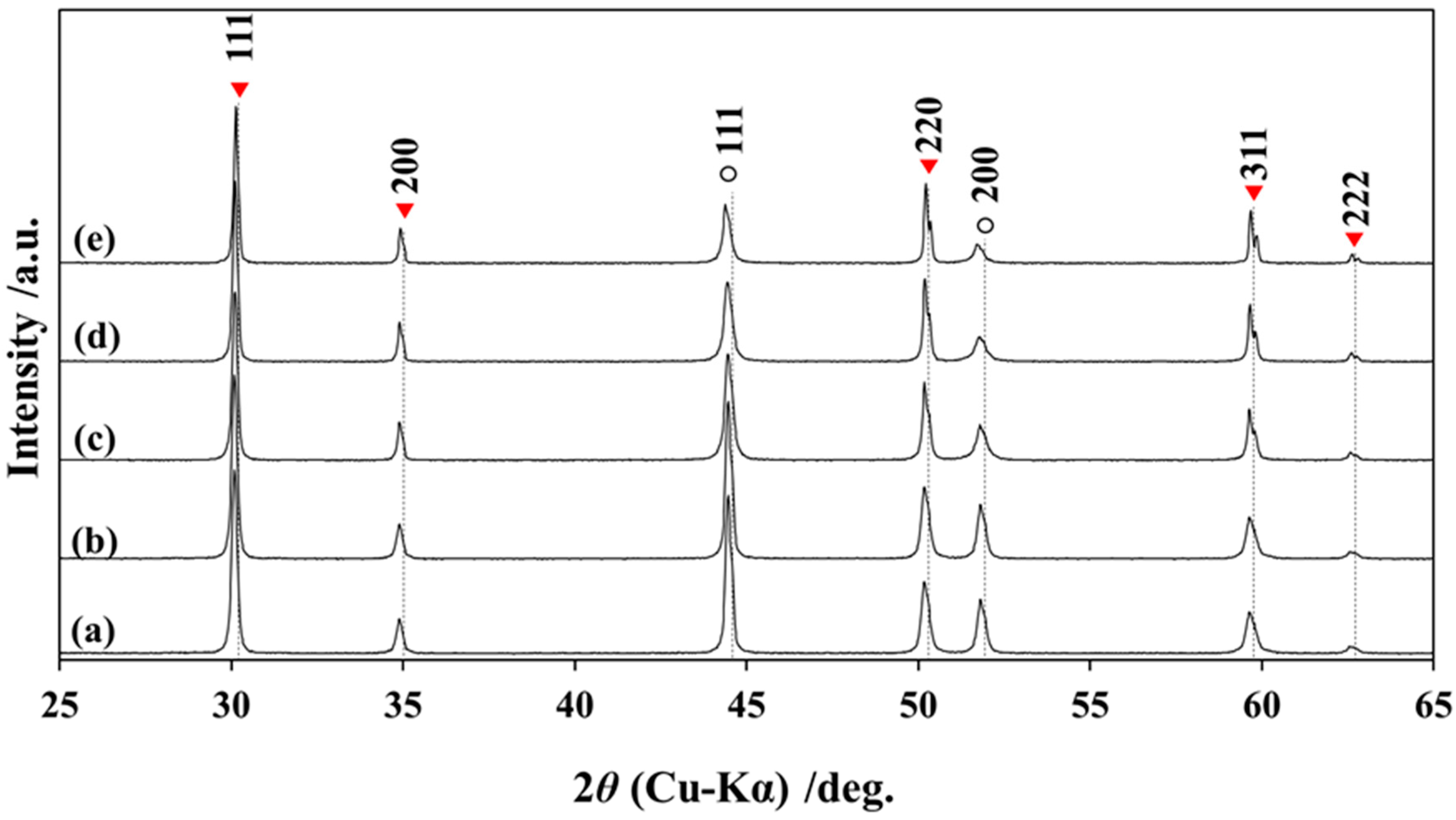
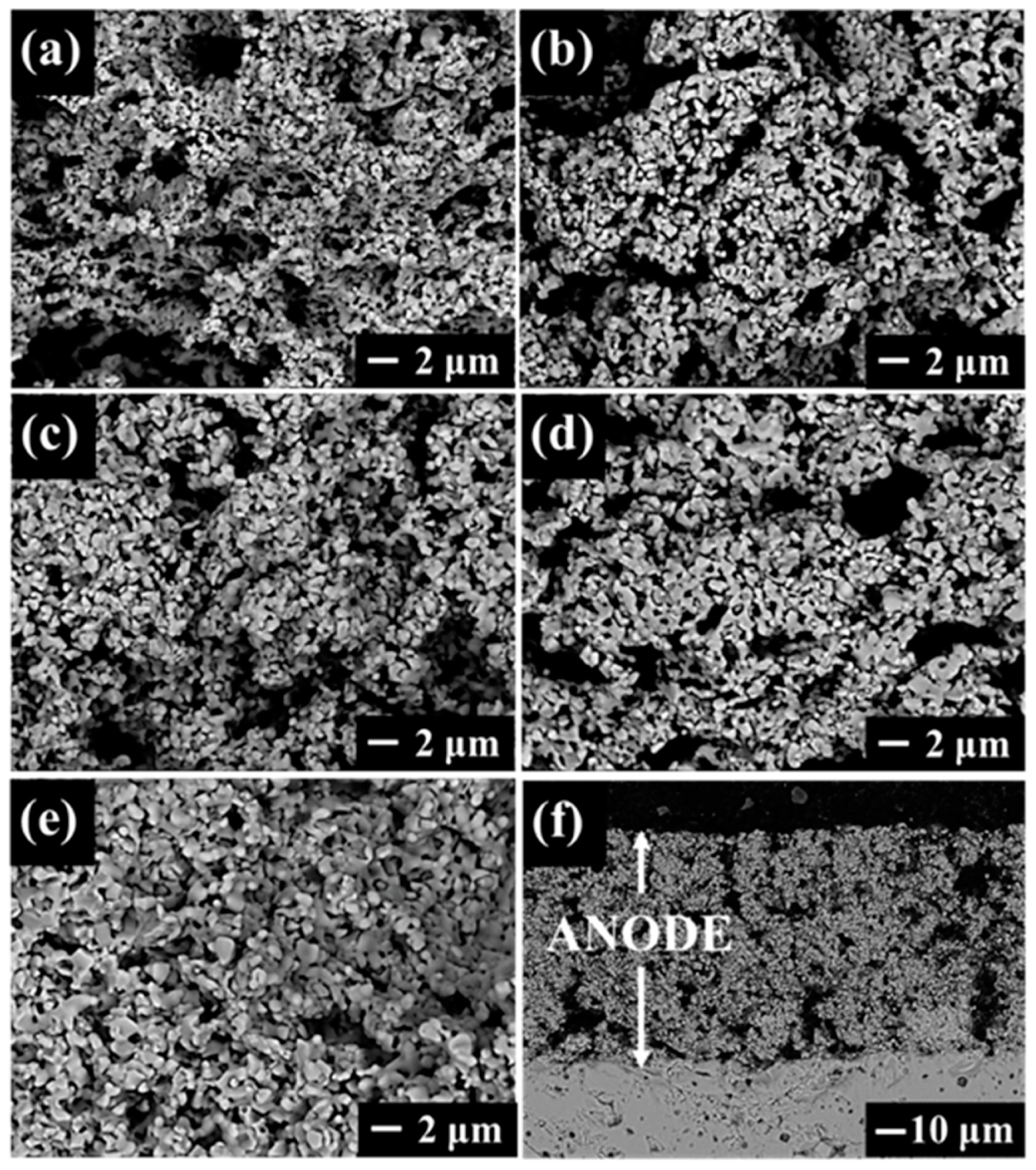
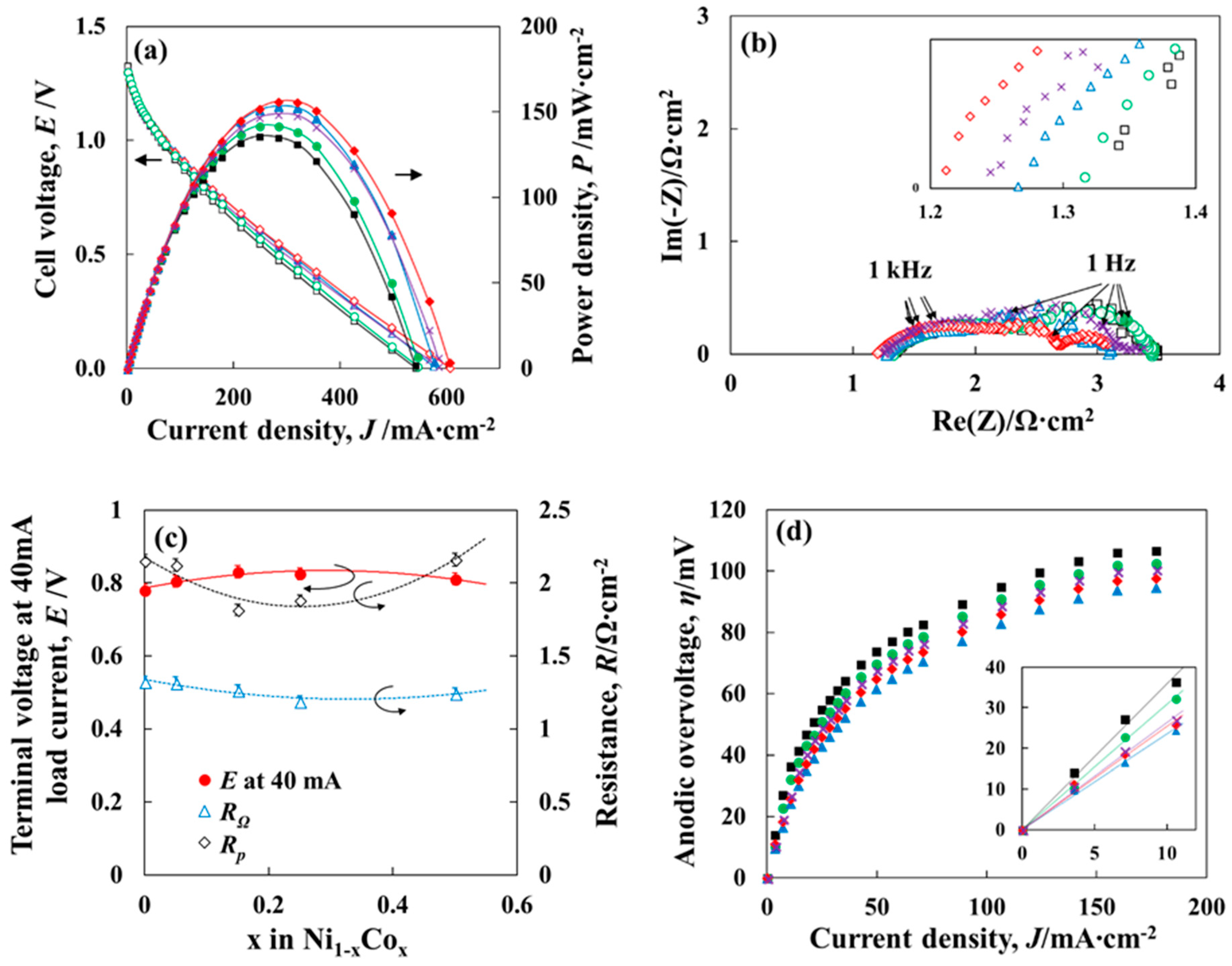
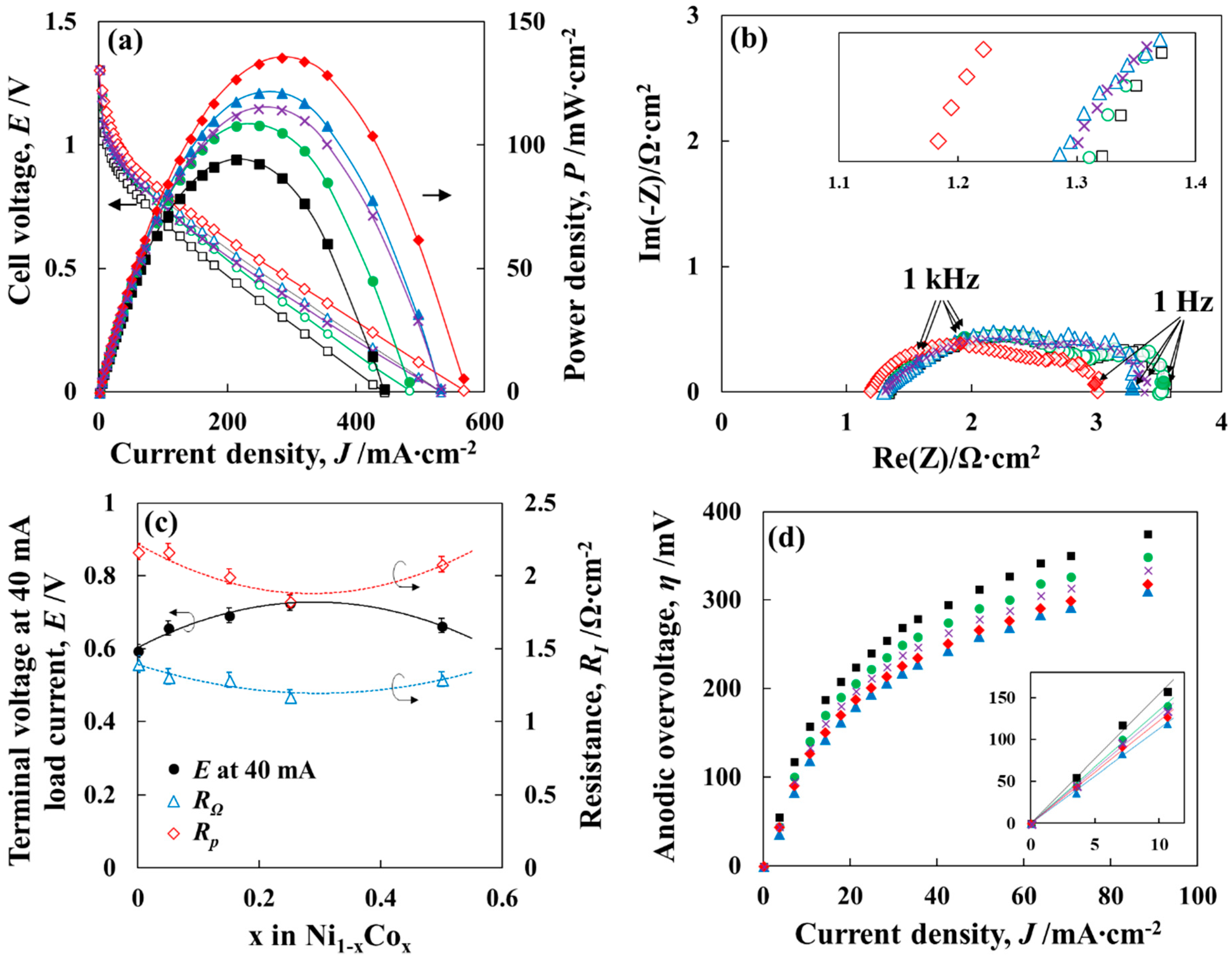
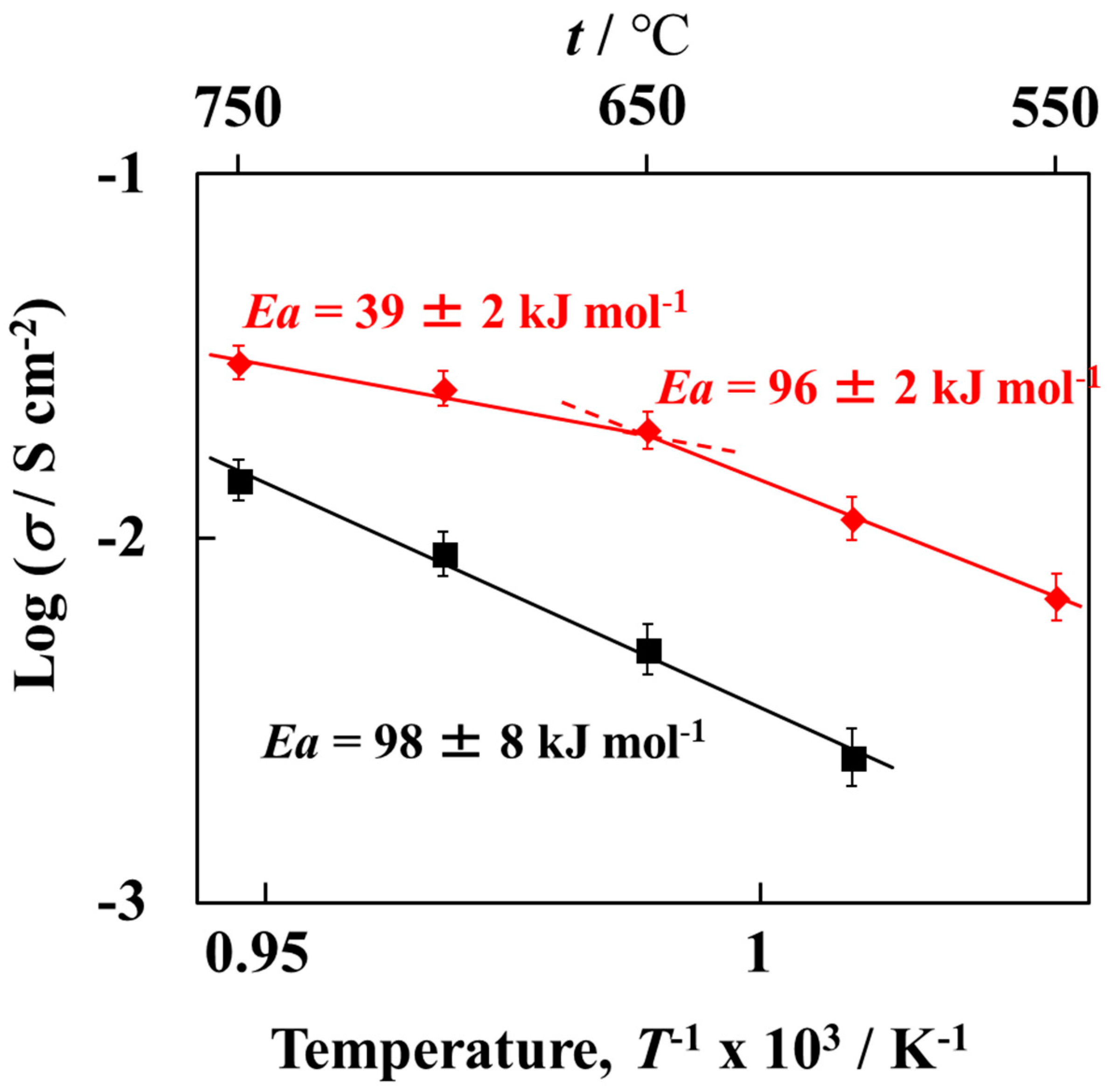
 : 0 h,
: 0 h,  : 60 h).
: 60 h).
 : 0 h,
: 0 h,  : 60 h).
: 60 h).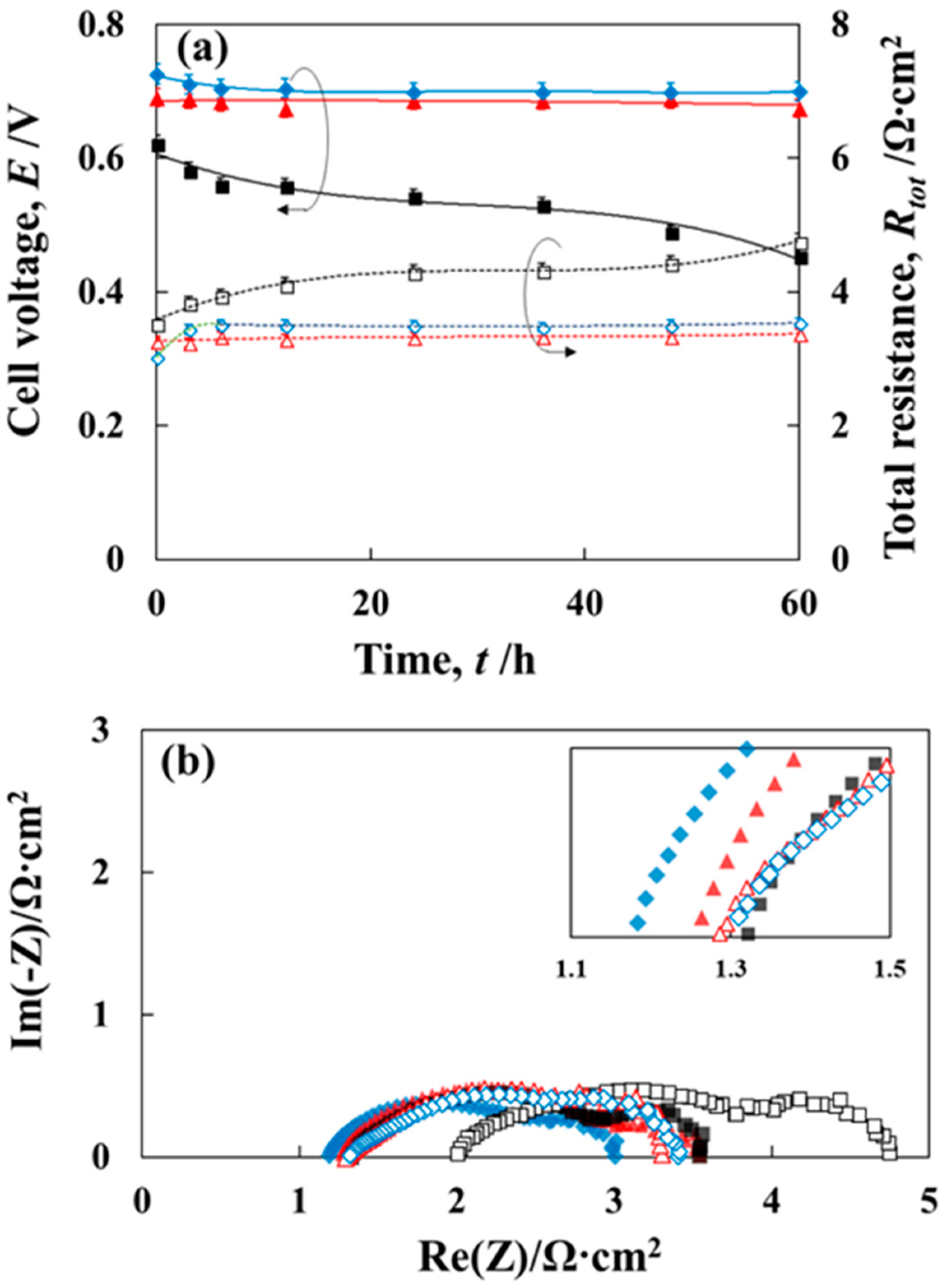
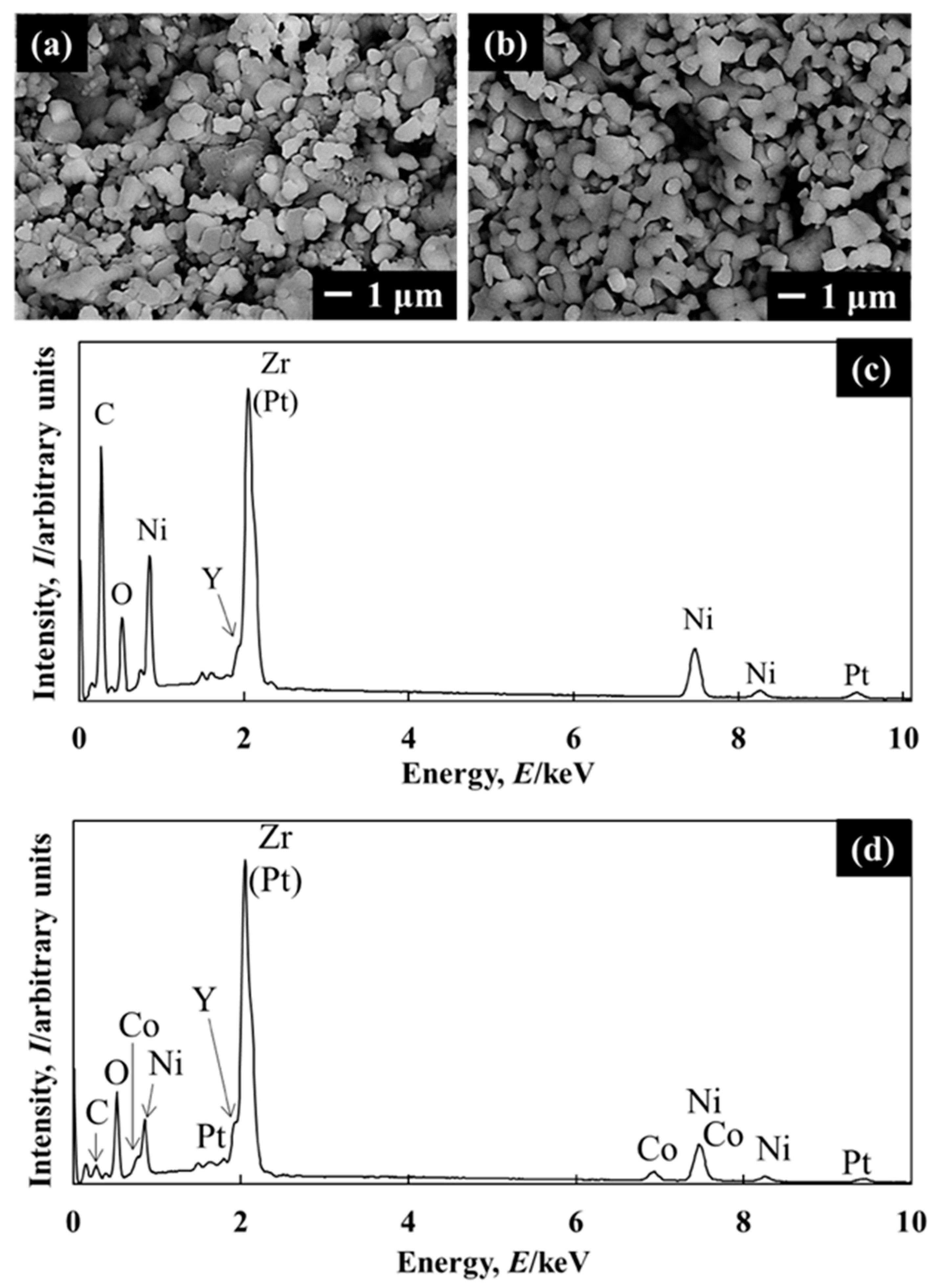
© 2020 by the authors. Licensee MDPI, Basel, Switzerland. This article is an open access article distributed under the terms and conditions of the Creative Commons Attribution (CC BY) license (http://creativecommons.org/licenses/by/4.0/).
Share and Cite
Wongsawatgul, N.; Chaianansutcharit, S.; Yamamoto, K.; Nanko, M.; Sato, K. Improved Electrochemical Properties of an Ni-Based YSZ Cermet Anode for the Direct Supply of Methane by Co Alloying with an Impregnation Method. Ceramics 2020, 3, 114-126. https://doi.org/10.3390/ceramics3010012
Wongsawatgul N, Chaianansutcharit S, Yamamoto K, Nanko M, Sato K. Improved Electrochemical Properties of an Ni-Based YSZ Cermet Anode for the Direct Supply of Methane by Co Alloying with an Impregnation Method. Ceramics. 2020; 3(1):114-126. https://doi.org/10.3390/ceramics3010012
Chicago/Turabian StyleWongsawatgul, Nicharee, Soamwadee Chaianansutcharit, Kazuhiro Yamamoto, Makoto Nanko, and Kazunori Sato. 2020. "Improved Electrochemical Properties of an Ni-Based YSZ Cermet Anode for the Direct Supply of Methane by Co Alloying with an Impregnation Method" Ceramics 3, no. 1: 114-126. https://doi.org/10.3390/ceramics3010012
APA StyleWongsawatgul, N., Chaianansutcharit, S., Yamamoto, K., Nanko, M., & Sato, K. (2020). Improved Electrochemical Properties of an Ni-Based YSZ Cermet Anode for the Direct Supply of Methane by Co Alloying with an Impregnation Method. Ceramics, 3(1), 114-126. https://doi.org/10.3390/ceramics3010012




